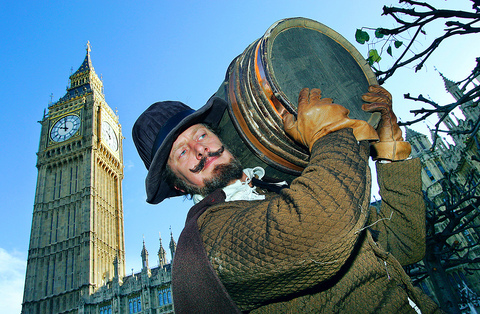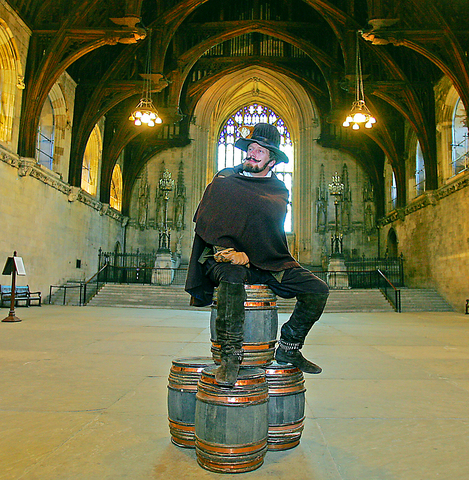Even by the standards of today's global terrorism, it was a bold and brazen act: sneaking 36 barrels of gunpowder under the Houses of Parliament and blowing England's power elite to smithereens.
Tonight, the night sky across Britain will be alive with bonfires and pyrotechnics for the 400th anniversary of the gunpowder plot -- an unofficial holiday better known as Bonfire Night or Guy Fawkes Day.
Comparisons with the July 7 attacks in London, in which 52 subway and bus commuters were killed by four apparent Islamist suicide bombers in the deadliest act of terrorism ever on British soil, may perhaps be inevitable.

PHOTOS: AFP
Enduring, however, will be the popular fascination with Fawkes and his co-conspirators, drawn from a then-repressed Catholic minority who apparently felt that the nation, by embracing Protestantism, was treading the wrong path.
More than 50,000 people have already visited a gunpowder plot exhibition since it opened in July in the Gothic parliament buildings on the banks of the River Thames -- ground zero for the blast that might have been.
"Obviously there is a resonance [to contemporary terrorism], but we'd rather like people to come to their own conclusions," said the exhibition's project manager David Prior.

Other commemorations are underway at the Tower of London, the National Portrait Gallery, the National Archives (where Fawkes' signed confession is on display) and the Shakespearean Globe theater.
In a turn unthinkable for the likes of Osama bin Laden or the Irish Republican Army, the Museum of London is holding a day-long study today titled: "Understanding Guy Fawkes."
In southeast England, meanwhile, huge crowds are once again expected in the sleepy town of Lewes, East Sussex for Britain's biggest Nov. 5 gathering, a night of bonfires, fireworks, effigies and residual anti-Papist motifs.
Exactly how the gunpowder plot was cooked up is a fact lost in the haze of time, according to a fact sheet helpfully provided by the House of Commons information office on its Web site (www.parliament.gov.uk).
"Generations of historians accepted it as a genuine last desperate attempt to re-establish the Catholic religion," although another theory is that the plotters were actually agents provocateur aiming to discredit Catholics and reinforce Protestantism, it said.
One way or another, Fawkes and his original gang of four co-conspirators -- the numbers grew in time, making it harder to keep secrecy -- decided in 1604 to blow up parliament on Nov. 5, 1605, the day of its state opening.
The king would be there, along with his heir apparent, and every member of the House of Commons and the House of Lords.
The 36 barrels of gunpowder, big and small, were smuggled into a coal room beneath the parliament leased by one of the conspirators, and the plan was for army veteran Fawkes to light the fuses and then skedaddle to mainland Europe.
The official version is that a Catholic peer got a timely tip off, prompting a midnight search in which Fawkes was cornered in the basement with his deadly pile of barrels hidden under black coal.
While all the conspirators were rounded up, Londoners rejoiced on the streets at the plot's failure.
The scene turned gruesome in subsequent months as Fawkes and his cohorts, in the fashion of the day, were tried, tortured, disemboweled alive, then hanged and quartered for treason.
Exactly how much destruction they would have wrought in the heart of London has been and remains today a topic of heated scholarly debate.
Researchers at the University of Wales reckoned two years ago that the blast would have devastated a 490m radius -- an area that would include today's Downing Street, Foreign Office and Ministry of Defense.
But an ambitious re-creation of the blast by ITV television, using sensors and crash-test dummies, suggested that the impact would have been relatively contained, though with debris raining over 200m.
"We concluded that he [Fawkes] could have killed everyone present with half the amount of explosive," added David Hadden, a blast consultant on The Gunpowder Plot: Exploding the Legend.
Historian Justin Pollard told the program: "The whole plot was massively ill-conceived."
"They seemed to think they could change the politics of the whole country by blowing up a few hundred people."
"In reality, the blast would have sent shockwaves through the Protestant community, bolstering their resolve against the hugely outnumbered Catholics and sparking ruthless revenge."

On April 26, The Lancet published a letter from two doctors at Taichung-based China Medical University Hospital (CMUH) warning that “Taiwan’s Health Care System is on the Brink of Collapse.” The authors said that “Years of policy inaction and mismanagement of resources have led to the National Health Insurance system operating under unsustainable conditions.” The pushback was immediate. Errors in the paper were quickly identified and publicized, to discredit the authors (the hospital apologized). CNA reported that CMUH said the letter described Taiwan in 2021 as having 62 nurses per 10,000 people, when the correct number was 78 nurses per 10,000

As we live longer, our risk of cognitive impairment is increasing. How can we delay the onset of symptoms? Do we have to give up every indulgence or can small changes make a difference? We asked neurologists for tips on how to keep our brains healthy for life. TAKE CARE OF YOUR HEALTH “All of the sensible things that apply to bodily health apply to brain health,” says Suzanne O’Sullivan, a consultant in neurology at the National Hospital for Neurology and Neurosurgery in London, and the author of The Age of Diagnosis. “When you’re 20, you can get away with absolute

May 5 to May 11 What started out as friction between Taiwanese students at Taichung First High School and a Japanese head cook escalated dramatically over the first two weeks of May 1927. It began on April 30 when the cook’s wife knew that lotus starch used in that night’s dinner had rat feces in it, but failed to inform staff until the meal was already prepared. The students believed that her silence was intentional, and filed a complaint. The school’s Japanese administrators sided with the cook’s family, dismissing the students as troublemakers and clamping down on their freedoms — with

As Donald Trump’s executive order in March led to the shuttering of Voice of America (VOA) — the global broadcaster whose roots date back to the fight against Nazi propaganda — he quickly attracted support from figures not used to aligning themselves with any US administration. Trump had ordered the US Agency for Global Media, the federal agency that funds VOA and other groups promoting independent journalism overseas, to be “eliminated to the maximum extent consistent with applicable law.” The decision suddenly halted programming in 49 languages to more than 425 million people. In Moscow, Margarita Simonyan, the hardline editor-in-chief of the